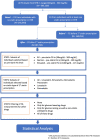Modest effect of statins on fasting glucose in a longitudinal electronic health record based cohort
- PMID: 35836181
- PMCID: PMC9284686
- DOI: 10.1186/s12933-022-01566-w
Modest effect of statins on fasting glucose in a longitudinal electronic health record based cohort
Abstract
Background: Prior studies of the glycemic effect of statins have been inconsistent. Also, most studies have only considered a short duration of statin use; the effect of long-term statin use on fasting glucose (FG) has not been well examined. The aim of this work is to investigate the effect of long-term statin exposure on FG levels.
Methods: Using electronic health record (EHR) data from a large and diverse longitudinal cohort, we defined long-term statin exposure in two ways: the cumulative years of statin use (cumulative supply) and the years' supply-weighted sum of doses (cumulative dose). Simvastatin, lovastatin, atorvastatin and pravastatin were included in the analysis. The relationship between statin exposure and FG was examined using linear regression with mixed effects modeling, comparing statin users before and after initiating statins and statin never-users.
Results: We examined 593,130 FG measurements from 87,151 individuals over a median follow up of 20 years. Of these, 42,678 were never-users and 44,473 were statin users with a total of 730,031 statin prescriptions. FG was positively associated with cumulative supply of statin but not comulative dose when both measures were in the same model. While statistically significant, the annual increase in FG attributable to statin exposure was modest at only 0.14 mg/dl, with only slight and non-significant differences among statin types.
Conclusions: Elevation in FG level is associated with statin exposure, but the effect is modest. The results suggest that the risk of a clinically significant increase in FG attributable to long-term statin use is small for most individuals.
Keywords: Cohort study; Fasting glucose; Statin.
© 2022. The Author(s).
Conflict of interest statement
The authors declare no competing interests.
Figures



Similar articles
-
Effect of statins on fasting glucose in non-diabetic individuals: nationwide population-based health examination in Korea.Cardiovasc Diabetol. 2018 Dec 5;17(1):155. doi: 10.1186/s12933-018-0799-4. Cardiovasc Diabetol. 2018. PMID: 30518364 Free PMC article.
-
The Risk of Muscular Events Among New Users of Hydrophilic and Lipophilic Statins: an Observational Cohort Study.J Gen Intern Med. 2021 Sep;36(9):2639-2647. doi: 10.1007/s11606-021-06651-6. Epub 2021 Mar 9. J Gen Intern Med. 2021. PMID: 33751411 Free PMC article.
-
Comparative risk of lipophilic and hydrophilic statins on incident depression: A retrospective cohort study.J Affect Disord. 2018 Oct 1;238:542-546. doi: 10.1016/j.jad.2018.06.021. Epub 2018 Jun 15. J Affect Disord. 2018. PMID: 29936394
-
Pharmacodynamics and pharmacokinetics of the HMG-CoA reductase inhibitors. Similarities and differences.Clin Pharmacokinet. 1997 May;32(5):403-25. doi: 10.2165/00003088-199732050-00005. Clin Pharmacokinet. 1997. PMID: 9160173 Review.
-
Do statins beneficially or adversely affect glucose homeostasis?Curr Vasc Pharmacol. 2010 Sep;8(5):612-31. doi: 10.2174/157016110792006879. Curr Vasc Pharmacol. 2010. PMID: 20507274 Review.

